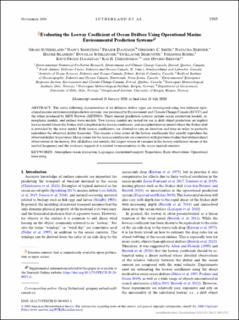Evaluating the leeway coefficient of ocean drifters using operational marine environmental prediction systems
Sutherland, Graig; Soontiens, Nancy; Davidson, Fraser; Smith, Gregory C.; Bernier, Natacha; Blanken, Hauke; Schillinger, Douglas; Marcotte, Guillaume; Röhrs, Johannes; Dagestad, Knut-Frode; Christensen, Kai Håkon; Breivik, Øyvind
Journal article, Peer reviewed
Published version

Åpne
Permanent lenke
https://hdl.handle.net/11250/2761687Utgivelsesdato
2020Metadata
Vis full innførselSamlinger
- Geophysical Institute [1198]
- Registrations from Cristin [9791]
Originalversjon
Journal of Atmospheric and Oceanic Technology. 2020, 37(11), 1943–1954 10.1175/JTECH-D-20-0013.1Sammendrag
The water following characteristics of six different drifter types are investigated using two different operational marine environmental prediction systems: one produced by Environment and Climate Change Canada (ECCC) and the other produced by MET Norway (METNO). These marine prediction systems include ocean circulation models, atmospheric models, and surface wave models. Two leeway models are tested for use in drift object prediction: an implicit leeway model where the Stokes drift is implicit in the leeway coefficient, and an explicit leeway model where the Stokes drift is provided by the wave model. Both leeway coefficients are allowed to vary in direction and time in order to perfectly reproduce the observed drifter trajectory. This creates a time series of the leeway coefficients that exactly reproduce the observed drifter trajectories. Mean values for the leeway coefficients are consistent with previous studies that utilized direct observations of the leeway. For all drifters and models, the largest source of variance in the leeway coefficient occurs at the inertial frequency and the evidence suggests it is related to uncertainties in the ocean inertial currents.